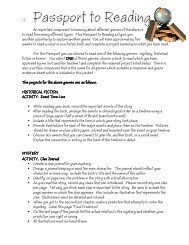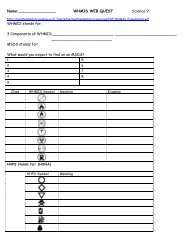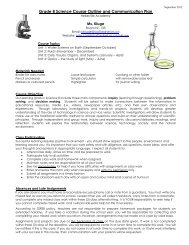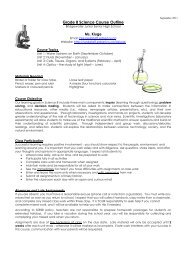1 Unit 4 â Conservation of Mass and Stoichiometry
1 Unit 4 â Conservation of Mass and Stoichiometry
1 Unit 4 â Conservation of Mass and Stoichiometry
Create successful ePaper yourself
Turn your PDF publications into a flip-book with our unique Google optimized e-Paper software.
E. Compounds Containing Polyatomic Ions<br />
1. Oxyanions<br />
a. Polyatomic anions that contain oxygen<br />
2. Naming a series <strong>of</strong> similar polyatomic ions<br />
ClO - -<br />
ClO 2<br />
-<br />
ClO 3<br />
-<br />
ClO 4<br />
Hypochlorite Chlorite Chlorate Perchlorate<br />
3. Naming compounds containing polyatomic ions<br />
a. Same as for monatomic ions<br />
4. Writing formulas including polyatomic ions<br />
a. Use parentheses when you need MORE THAN one <strong>of</strong> a polyatomic ion<br />
b. Parentheses are NEVER used for monatomic ions, regardless <strong>of</strong> how many are in the<br />
formula<br />
IV.<br />
Naming Binary Molecular Compounds<br />
A. Binary Molecular Compounds<br />
1. Covalently bonded molecules containing only two elements, both nonmetals<br />
B. Naming<br />
1. Least electronegative element is named first<br />
2. First element gets a prefix if there is more than 1 atom <strong>of</strong> that element<br />
3. Second element ALWAYS gets a prefix, <strong>and</strong> an “-ide” ending<br />
Examples: N 2 O 3 = dinitrogen trioxide<br />
CO = carbon monoxide, not monocarbon monoxide<br />
Table 7-3<br />
Numerical Prefixes<br />
Number 1 2 3 4 5 6 7 8 9 10<br />
Prefix mono di tri tetra penta hexa hepta octa nona deca<br />
7-3 Using Chemical Formulas<br />
I. Formula <strong>Mass</strong>es<br />
A. Formula <strong>Mass</strong><br />
1. The sum <strong>of</strong> the average atomic masses <strong>of</strong> all the atoms represented in the formula <strong>of</strong> a molecule,<br />
formula unit, or ion<br />
Formula <strong>Mass</strong> <strong>of</strong> glucose, C 6 H 12 O 6 :<br />
C = 12.01 amu 6 x 12.01 amu = 72.06 amu<br />
H = 1.01 amu 12 x 1.01 amu = 12.12 amu<br />
O = 16.00 amu 6 x 16.00 amu = 96.00 amu<br />
Formula <strong>Mass</strong> = 180.18 amu<br />
B. Molar <strong>Mass</strong>es<br />
1. A compound's molar mass is numerically equal to it formula mass, but expressed in units <strong>of</strong><br />
grams/mole (g/mol)<br />
Molar <strong>Mass</strong> <strong>of</strong> glucose, C 6 H 12 O 6 = 180.18 g/mol<br />
II.<br />
Molar <strong>Mass</strong> as a Conversion Factor<br />
A. Converting moles <strong>of</strong> compound to grams<br />
Amount in moles x molar mass(<br />
g / mol)<br />
= <strong>Mass</strong><br />
in<br />
grams<br />
B. Converting grams <strong>of</strong> compound to mass<br />
1<br />
<strong>Mass</strong> in grams x<br />
=<br />
molar mass(<br />
g / mol)<br />
Amount<br />
<strong>of</strong><br />
moles<br />
2



